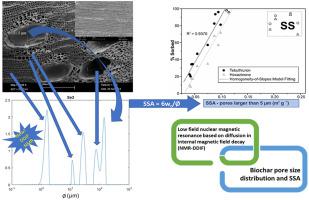Chemosphere ( IF 8.8 ) Pub Date : 2021-09-14 , DOI: 10.1016/j.chemosphere.2021.132237 Letícia de Pierri 1 , Etelvino Henrique Novotny 2 , Carlos Eduardo Pellegrino Cerri 1 , Adijailton José de Souza 1 , Bianca Braz Mattos 2 , Valdemar Luiz Tornisielo 3 , Jussara Borges Regitano 1

|
Agrowaste biochars [sugarcane straw (SS), rice husk (RH), poultry manure (PM), and sawdust (SW)] were synthesized at different pyrolysis temperatures (350, 450, 550, and 650 °C) to evaluate their potential to retain highly mobile herbicides, such as hexazinone and tebuthiuron that often contaminate water resources around sugarcane plantations. A new low field nuclear magnetic resonance approach based on decay due to diffusion in internal magnetic field (NMR-DDIF) was successfully used to determine biochar's porosity and specific surface area (SSA) to clear the findings of this work. SSA of pores with diameters >5.0 μm increased with pyrolysis temperatures and seemed to dictate biochar's retention, which was >70% of the applied amounts at 650 °C. These macropores appear to act as main arteries for herbicide intra-particle diffusion into smaller pores, thus enhancing herbicides retention. Biochar granulometry had little, but herbicide aging had a significant effect on sorption, mainly of tebuthiuron. However, soils amended with 10,000 kg ha−1 of the biochars showed low sorption potential. Therefore, higher than usual biochar rates or proper incorporation strategies, i.e., surface incorporation, will be needed to remediate areas contaminated with these highly mobile herbicides, thus precluding their leaching to groundwaters.
中文翻译:

使用新的低场 NMR 方法获取生物炭的孔隙率及其对高流动性除草剂保留的影响
农用生物炭 [甘蔗秸秆 (SS)、稻壳 (RH)、家禽粪便 (PM) 和锯末 (SW)] 在不同的热解温度(350、450、550 和 650 °C)下合成,以评估它们的潜力保留高度流动的除草剂,例如经常污染甘蔗种植园周围水资源的六嗪酮和丁硫脲。基于内部磁场扩散引起的衰变的新低场核磁共振方法 (NMR-DDIF) 已成功用于确定生物炭的孔隙率和比表面积 (SSA),以澄清这项工作的发现。直径 > 5.0 μm 的孔的 SSA 随热解温度增加而增加,似乎决定了生物炭的保留率,在 650 °C 时占应用量的 70% 以上。这些大孔似乎充当了除草剂颗粒内扩散到较小孔中的主要动脉,从而增强了除草剂的保留。生物炭粒度测定几乎没有,但除草剂老化对吸附有显着影响,主要是对丁硫脲的吸附。然而,土壤改良了 10,000 公斤公顷-1的生物炭显示出低吸附潜力。因此,需要比通常更高的生物炭比率或适当的掺入策略,即表面掺入,以修复被这些高流动性除草剂污染的区域,从而防止它们渗入地下水。

























 京公网安备 11010802027423号
京公网安备 11010802027423号